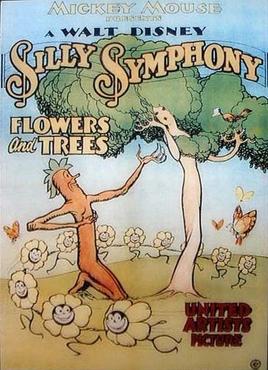Related Research Articles
Silly Symphony is an American animated series of 75 musical short films produced by Walt Disney Productions from 1929 to 1939. As the series name implies, the Silly Symphonies were originally intended as whimsical accompaniments to pieces of music. As such, the films usually did not feature continuing characters, unlike the Mickey Mouse shorts produced by Disney at the same time. The series is notable for its innovation with Technicolor and the multiplane motion picture camera, as well as its introduction of the character Donald Duck, who made his first appearance in the Silly Symphony cartoon The Wise Little Hen in 1934. Seven shorts won the Academy Award for Best Animated Short Film.

Flowers and Trees is a Silly Symphonies cartoon produced by Walt Disney, directed by Burt Gillett, and released to theatres by United Artists on July 30, 1932. It was the first commercially released film to be produced in the full-color three-strip Technicolor process after several years of two-color Technicolor films. The film was a commercial and critical success, winning the first Academy Award for Best Cartoon Short Subject.

Mother Goose Goes Hollywood is a 1938 animated short film produced by Walt Disney Productions and distributed by RKO Radio Pictures. The short was released on December 23, 1938. The film parodies several Mother Goose nursery rhymes using caricatures of popular Hollywood film stars of the 1930s. The film was directed by Wilfred Jackson and was the third-to-last Silly Symphony produced.

The Country Cousin is a Walt Disney animated short film released on October 31, 1936, by United Artists. The winner of an Oscar at the 9th Academy Awards for Best Animated Short Film, the film was produced by Walt Disney, directed by Wilfred Jackson, and animated by Art Babbitt and Les Clark. As is true for most cartoons in the Silly Symphonies series, The Country Cousin was built around a musical score, which was written by Leigh Harline. The film's story was based on one of Aesop's Fables, The Town Mouse and the Country Mouse. It was accompanied by a storybook for young children, which was common for many of the Silly Symphonies.

Three Blind Mouseketeers is a Silly Symphonies cartoon based on the nursery rhyme Three Blind Mice and the 1844 novel The Three Musketeers by Alexandre Dumas. Directed by Dave Hand and Jack Cutting, it stars Billy Bletcher.
The Spider and the Fly is a 1931 Silly Symphonies cartoon.
The Flying Mouse is a Silly Symphonies cartoon produced by Walt Disney, directed by David Hand, and released to theatres by United Artists on July 14, 1934. The use of color here was rather innovative as it is set during the course of a single day.

The Robber Kitten is a 1935 Walt Disney Silly Symphonies cartoon, directed by David Hand. The short is based on a story of the same name written by Robert Michael Ballantyne with the pseudonym Comus.

Springtime is a Silly Symphonies animated Disney short film. It was released in 1929. It was the third Silly Symphonies film to be produced, just five days before the 1929 Stock Market Crash. The short entered the US public domain on January 1, 2025.
The China Plate is a 1931 Silly Symphonies animated film.
Arctic Antics is a Silly Symphonies animated Disney short film. It was released on June 26, 1930.
The Clock Store is a Silly Symphonies animated Disney short film. It was released in 1931.
The Bird Store is a Silly Symphonies animated Disney short film. It was released on January 16, 1932, by Columbia Pictures. The cartoon marks the first recorded voice work of Clarence Nash for Walt Disney Productions, and was also the final cartoon in the Silly Symphonies series to be released by Columbia Pictures.

Father Noah's Ark is a Walt Disney Silly Symphonies animated film. It is based on the biblical narrative of Noah's Ark. The short's musical score is an adaptation of the first dance in Ludwig van Beethoven's 12 Contredanses. The cartoon was released on April 8, 1933.
Peculiar Penguins is a Silly Symphonies animated short film produced by Walt Disney Productions. It was released in 1934. The song played during the cartoon is called "The Penguin Is a Very Funny Creature", by Leigh Harline.

Woodland Café is a Silly Symphonies animated Disney short film. It was filmed in Technicolor and released by United Artists in 1937 and was re-issued by RKO Radio Pictures in 1948. While it contained no on-screen credits, Wilfred Jackson was the director and Leigh Harline was the musical director.

Farmyard Symphony is a 1938 Silly Symphonies animated short film. It can be seen as a precursor to Fantasia due to using various pieces of classical music in one short. The film was directed by Jack Cutting and produced by Walt Disney.
The Miller's Daughter is a 1934 Warner Bros. Merrie Melodies cartoon directed by Friz Freleng. The short was released on October 13, 1934.

The Night Before Christmas, also known as Santa's Toys, is a 1933 American pre-Code animated short film produced by Walt Disney Productions and released by United Artists. Part of the Silly Symphony series, the film is an adaptation of Clement Clarke Moore's 1823 poem "A Visit from St. Nicholas", popularly called "The Night Before Christmas". The film was directed by Disney animator Wilfred Jackson.

Moth and the Flame is a Silly Symphony short film released on April 1, 1938.
References
- 1 2 Merritt, Russell; Kaufman, J. B. (2016). Walt Disney's Silly Symphonies: A Companion to the Classic Cartoon Series (2nd ed.). Glendale, CA: Disney Editions. pp. 136–137. ISBN 978-1-4847-5132-9.
- ↑ Lenburg, Jeff (1999). The Encyclopedia of Animated Cartoons. Checkmark Books. pp. 135–136. ISBN 0-8160-3831-7.
- ↑ https://dvdizzy.com/beautyandthebeastb.html